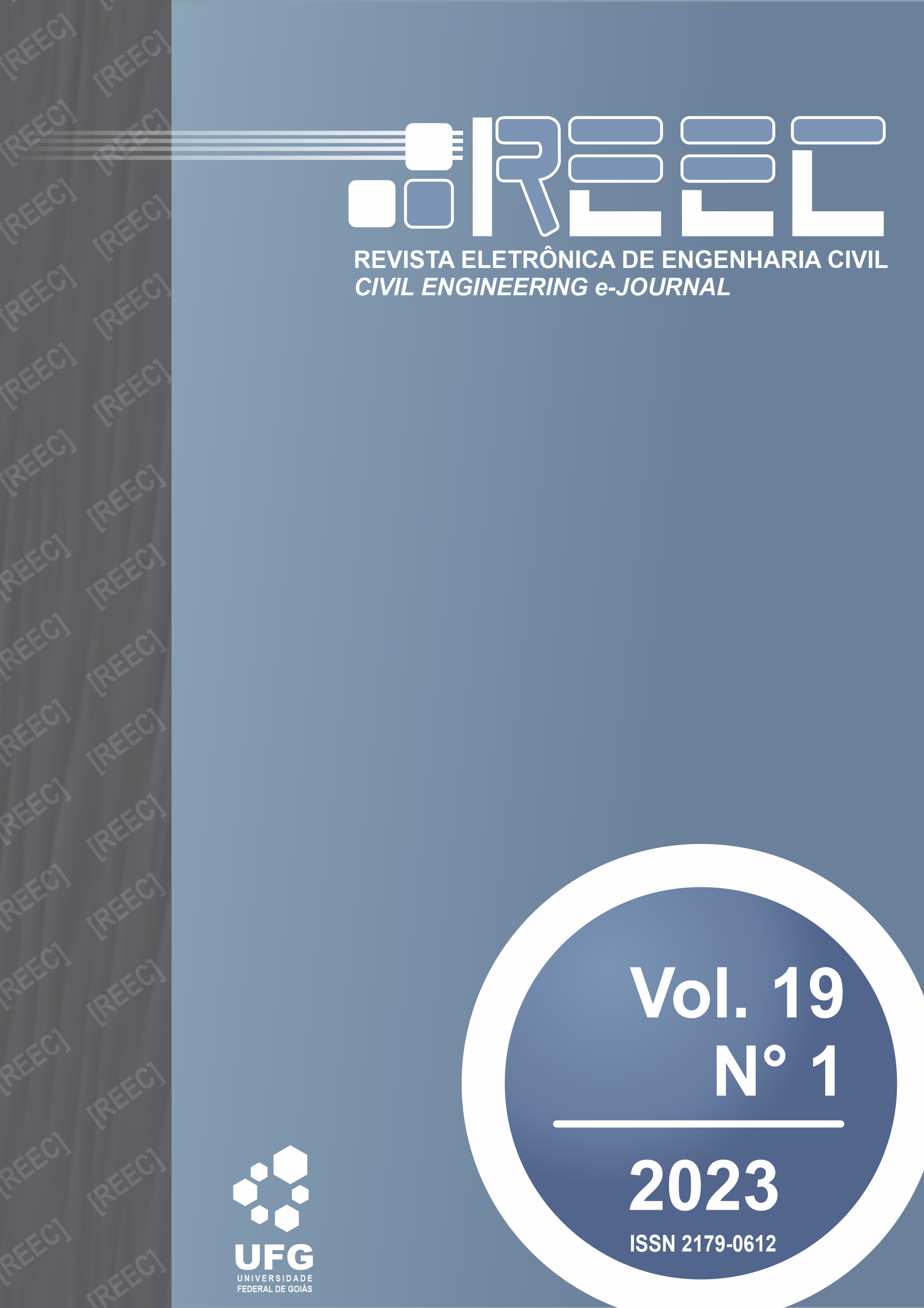AVALIAÇÃO DO COMPORTAMENTO REOLÓGICO DAS MATRIZES CIMENTÍCIAS COM A ADIÇÃO DE NANOTUBOS DE CARBONO: UMA REVISÃO SISTEMÁTICA DA LITERATURA (RSL) – PARTE 2
DOI:
https://doi.org/10.5216/reec.v19i1.76627Palavras-chave:
Reologia, Tensão de escoamento, Taxa de cisalhamento, Matriz cimentícia, Nanotubo de carbonoResumo
RESUMO: Os nano-materiais têm sido cada vez mais empregados nos compósitos cimentícios, visto que estes são tipicamente caracterizados como materiais frágeis com baixa resistência à tração e baixa capacidade de deformação. Dentro da categoria de nano-materiais encontram-se os nanotubos de carbono (NTCs). Este trabalho faz uma continuação da Parte 1, trazendo os resultados bibliométricos dessa RSL e as contribuições adquiridas para o estado da arte dos parâmetros reológicos das matrizes cimentícias reforçadas com NTCs. Diante dos resultados é possível concluir que a string de busca foi eficaz para encontrar pesquisas que estudam reologia de matrizes cimentícias incorporadas com NTCs. Contudo, a correlação dos artigos visando isolar o efeito dos NTCs se torna inviável diante da vasta disponibilidade de variações nas composições das matrizes cimentícias. De uma forma geral, foi verificada uma maior tendência no aumento da viscosidade ao introduzir NTCs nas matrizes, o que geralmente é atribuído à grande superfície específica dos NTCs. Diante da natureza hidrofóbica do NTCs, existe uma variedade de: matrizes cimentícias; características do NTC; funcionalização da superfície; aditivo utilizado no processo; método para dispersão adotado e suas características; teor de NTC incorporado em relação à massa de cimento; relação a/c; entre outros. Portanto, mais pesquisas devem ser desenvolvidas de forma a correlacionar as variáveis que circundam os NTCs para potencializar seu uso nos compósitos cimentícios.
Downloads
Referências
ANDRADE NETO J.S., SANTOS T.A., PINTO S.A., DIAS C.M.R., RIBEIRO D.V. Effect of the combined use of carbon nanotubes (CNT) and metakaolin on the properties of cementitious matrices. Construction & Building Materials. Vol. 271. 2021.
AZEVEDO, N.H.; MATOS, P.R.; GLEIZE, P.J.P.; BETIOLI, A.M. Effect of thermal treatment of SiC nanowhiskers on rheological, hydration, mechanical and microstructure properties of Portland cement pastes. Cement and Concrete Composites, v.117, 2021.
CHUAH, S.; PAN, Z.; SANJAYAN, J. G.; WANG, C. M.; DUAN, W. H. Nano reinforced cement and concrete composites and new perspective from graphene oxide. Construction and Building Materials, v. 73, 2014, 113 – 124 p.
FAROOQ F., AKBAR A., KHUSHNOOD R.A., MUHAMMAD W.L.B., REHMAN S.K.U., JAVED M.F. Experimental investigation of hybrid carbon nanotubes and graphite nanoplatelets on rheology, shrinkage, mechanical, and microstructure of SCCM. Materials. Vol. 13, n. 230. 2020.
GLEIZE, P. J. P. Nanotecnologia e Materiais de Construção. In: Materiais de construção civil e princípios de ciência e engenharia de materiais. Volume 2. 2. ed. São Paulo: IBRACON, 2010. 1719–1745 p.
HERBST, M. H.; MACÊDO, M. I. F.; ROCCO, A. M. Tecnologia dos nanotubos de carbono: tendências e perspectivas de uma área multidisciplinar. Quim. Nova, v. 27, n. 6, 2004, 986–992 p.
JIANG S., SHAN B., OUYANG J., ZHANG W., YU X., LI P., HAN B. Rheological properties of cementitious composites with nano/fiber fillers. Construction & Building Materials. Vol. 158. p. 786 – 800. 2018.
KIM J.-H., CHOI I.-J., CHUNG C.-W. Dispersion of single wall carbon nanotube using air entraining agent and its application to portland cement paste. Construction & Building Materials. Vol. 302. 2021.
KONSTA-GDOUTOS, M. S.; METAXA, Z. S.; SHAH, S. P. Highly dispersed carbon nanotube reinforced cement-based materials. Cement and Concrete Research, v. 40, n. 7, 2010, 1052–1059 p.
KOSTRZANOWSKA-SIEDLARZ, A. Statistical methods for determining rheological parameters of mortars modified with multi-walled carbon nanotubes. Construction & Building Materials. Vol. 253. 2020.
LEONAVIČIUS D., PUNDIENĖ I., GIRSKAS G., PRANCKEVIČIENĖ J., KLIGYS M., KAIRYTĖ A. The effect of multi-walled carbon nanotubes on the rheological properties and hydration process of cement pastes. Construction & Building Materials. Vol. 189, p. 947-954. 2018.
MA S., QIAN Y., KAWASHIMA S. Performance-based study on the rheological and hardened properties of blended cement mortars incorporating palygorskite clays and carbon nanotubes. Construction & Building Materials. Vol. 171, p. 663-671. 2018.
MACLEOD A.J.N., FEHERVARI A., GATES W.P., GARCEZ E.O., ALDRIDGE L.P., COLLINS F. Enhancing fresh properties and strength of concrete with a pre-dispersed carbon nanotube liquid admixture. Construction & Building Materials. Vol. 248. 2020.
MARCONDES, C. G. N.; MEDEIROS, M. H. F.; MARQUES FILHO, J.; HELENE, P. Nanotubos de carbono em concreto de cimento portland: Influência da dispersão nas propriedades mecânicas e na absorção de água. Alconpat, v. 5, n. 2. Maio-Agosto, 96-113, 2015 p.
MOHSEN, M. O.; TAHA, R.; TAQA, A. A.; AL-NUAIMI, N.; AL-RUB, R.A.; BANI-HANI, K.A. Effect of nanotube geometry on the strength and dispersion of CNT-cement composites. Journal of Nanomaterials, 2017, 1-15 p.
PAULA J.N., CALIXTO J.M., LADEIRA L.O., LUDVIG P., SOUZA T.C.C., ROCHA J.M., MELO A.A.V. Mechanical and rheological behavior of oil-well cement slurries produced with clinker containing carbon nanotubes. Journal of Petroleum Science & Engineering. Vol. 122. 2014. 274-279 p.
REALES O.A.M., DUDA P., TOLEDO FILHO R.D. Effect of a carbon nanotube/surfactant aqueous dispersion on the rheological and mechanical properties of portland cement pastes. Journal of Materials in Civil Engineering. Vol. 30, n 10. 2018.
REALES O.A.M., JARAMILLO Y.P.A., BOTERO J.C.O., DELGADO C.A., QUINTERO J.H., TOLEDO FILHO R.D. Influence of MWCNT/surfactant dispersions on the rheology of Portland cement pastes. Cement and Concrete Research. Vol. 107, 2018. 101-109 p.
REALES, O. A. M.; TOLEDO FILHO, R. D. A review on the chemical, mechanical and microstructural characterization of carbon nanotubes-cement based composites. Construction and Building Materials, v. 154, p. 697–710, 2017.
SANTOS, J. C. C. Síntese e caracterização de nanocompósitos PVA/Nanotubos de carbono para potencial aplicação biomédica. Dissertação. Programa de Pós-Graduação em Engenharia Metalúrgica e Materiais. Universidade Federal de Minas Gerais. Belo Horizonte, 2011.
SILVESTRO, L. Incorporação de nanotubos de carbono funcionalizados com silano em pastas de cimento Portland. Tese. Programa de Pós-Graduação em Engenharia Civil. Universidade Federal de Santa Catarina. Florianópolis, 2022a, 190 p.
SILVESTRO L., LIMA G.T. S., RUVIARO A.S., MEZALIRA D.Z., GLEIZE P.J.P. Effect of Multiwalled Carbon Nanotube Functionalization with 3-Aminopropyltriethoxysilane on the Rheology and Early-Age Hydration of Portland Cement Pastes. Journal of Materials in Civil Engineering. Vol. 34. 2022b.
SILVESTRO L., LIMA G.T. S., RUVIARO A.S., MATOS P.R., MEZALIRA D.Z., GLEIZE P.J.P. Evaluation of different organosilanes on multi-walled carbon nanotubes functionalization for application in cementitious composites. Journal of Materials in Civil Engineering. Vol. 51. 2022c.
SILVESTRO L., RUVIARO A.S., LIMA G.T. S., MATOS P.R., AZEVEDO A.R.G, MONTEIRO S.N., GLEIZE P.J.P. Influence of ultrasonication of functionalized carbon nanotubes on the rheology, hydration, and compressive strength of portland cement pastes. Materials. Vol. 14. 2021.
SOUZA T.C.C., PINTO G., CRUZ V.S., MOURA M., LADEIRA L.O., CALIXTO J.M. Evaluation of the rheological behavior, hydration process, and mechanical strength of Portland cement pastes produced with carbon nanotubes synthesized directly on clinker. Construction & Building Materials. 2020.
SKRIPKIUNAS G., KARPOVA E., BENDORAITIENE J., BARAUSKAS I. Rheological properties and flow behaviour of cement-based materials modified by carbon nanotubes and plasticising admixtures. Fluids. Vol. 5. 2020.
SKRIPKIUNAS G., KARPOVA E., BARAUSKAS I., BENDORAITIENE J., YAKOVLEV G. Rheological properties of cement pastes with multiwalled carbon nanotubes. Advances in Materials Science and Engineering. 2018. 13 p.
SKRIPKIUNAS G., YAKOVLEV G., KARPOVA E. The investigation of multi-walled carbon nanotubes dispersion and its influence on rheological properties of cement systems. MATEC Web of Conferences. 6º IPICSE. Vol. 251. 2018. Outubro. Moscow, Russia.
ZHANG J., QIU J., SHEN J., ZHANG M., JI H., YANG R. On the early behavior and microstructure of oil well cement paste incorporating with carbon nanotubes cured at a high temperature. Construction & Building Materials. Vol. 317. 2022.
Downloads
Publicado
Como Citar
Edição
Seção
Licença
Autores que publicam nesta revista concordam com os seguintes termos: Autores mantém os direitos autorais e concedem à revista o direito de primeira publicação, com o trabalho simultaneamente licenciado sob a Licença Creative Commons Attribution que permite o compartilhamento do trabalho com reconhecimento da autoria e publicação inicial nesta revista.
![[REEC] Revista Eletrônica de Engenharia Civil](https://revistas.ufg.br/public/journals/30/pageHeaderLogoImage_pt_BR.png)



